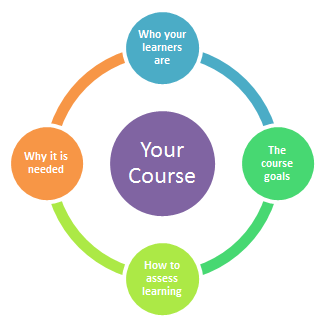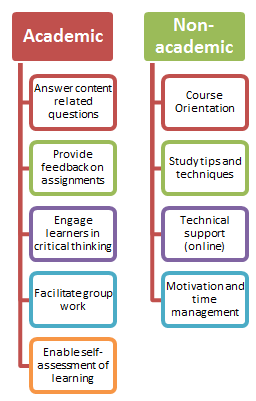Learner Support Strategy

Now that you know the essential intent for your course, who your learners are and how to assess student learning, you are ready to start making decisions about course delivery and how you will support your learners through the learning process.
Course Delivery Modes
When you decided to develop your course, you may have started out with pre-conceived ideas about how to make it available to students: fully online, through the Internet, or in a blended environment, with some sessions delivered online supplemented with a number of hours of classroom interaction. However, the information you gathered up until now about your audience, as well as the technical and physical infrastructure and budget available to you, and the strategic direction of your institution should inform your final decision.

Examples
If you are designing a course to upgrade Carpentry skills, you may want to consider a blended delivery model in which you may offer some of the theory online and allocate a minimum number of hours for hands-on learning in a carpentry shop. Then you need to consider your audience profile: if your learners are widely dispersed geographically, you may need to either consider having them travel to a community shop, in which case you will have to establish some community partnerships and offer some training, or you will have to consider having your instructors travel to local communities to deliver and support the experiential learning. As you can guess, these two options will have different impacts on your budget and on how you will design your course.This may seem a bit overwhelming to you right now, but rest assured, now is the time to think about it. Doing some thinking ahead and some planning will guide course design decisions further on. Like building a house: you don't start building before you have the architectural drawings that will guide the construction.

Activity
Update the Delivery Modes section of the course blueprint file with information about how the course you want to develop may be delivered.
How to support your learners should be an integral part of your conceptual planning process. An effective learner support strategy will impact the quality of the teaching and learning, and it will also impact your budget. Let's look at the two main categories for learner support next.
Types of Learner Support

When planning a learner support strategy make sure that it includes two levels of support, sustained by a variety of tactics, specific to your delivery context.
Some of these tactics may be fairly easy to implement and may not require too many resources. For example, academic support to enable self-assessment of learning may only require careful planning and design of self-assessment activities and investing in a set of good learner instructions. On the other hand, other tactics may require additional infrastructure. For example in the case of blended learning you will most likely need a room to facilitate the face-to-face sessions. In the case of online learning, it is extremely important that your students have access to a help-line to help them troubleshoot technical issues.
What is non-negotiable in terms of learner support, is that your students receive appropriate and timely feedback on their assignments. Therefore, any delivery mode must contemplate ways in which students can submit their work (by email, by mail, by telephone, etc.). Any learner support strategy must include a number of hours for instructors to provide guidance and feedback.

Activity
Update the Learner Support Plan section of the course blueprint file with information about learner support plan for the course you are designing.
